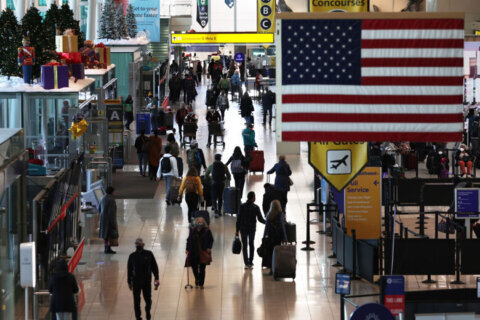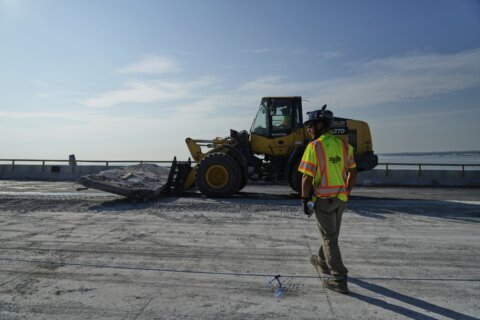More than a month since Baltimore’s Francis Scott Key Bridge collapsed after container ship Dali struck it in the early morning hours of March 26, Maryland transportation officials on Thursday offered an initial timeline and cost of resurrecting the bridge.
Maryland Transportation Secretary Paul Wiedefeld joined WTOP’s Shawn Anderson and Anne Kramer to talk about how the yearslong process could play out.
Shawn Anderson: We ask this with full understanding of the enormous task that’s ahead of you to clean up the wreckage and so forth. From your estimation, though, how long will it take to build a new Key Bridge?
Paul Wiedefeld: We believe it will take just over four years. So, we’re anticipating opening for service in the fall of 2028.
Anne Kramer: How do you get to that point, secretary, given how much still has to be done? And then how much do you have to take into account when it comes to finding the right company to do it, the right bidding process, all that is involved? Help us understand that a little bit better.
Paul Wiedefeld: Sure, as you can imagine, our first focus has been on recovery of the poor souls that were lost. We will continue to do that, and continue to work with Unified Command to do that. But at the same time, we’ve also been very active in thinking about rebuilding the bridge in terms of what it means to the Port of Baltimore, in terms of what it means to the communities, and obviously what it means to traffic up and down to Northeast Corridor of the nation.
So, because of that, we’ve been working very hard looking at, historically, some of the work that we’ve done. We recently replaced the Nice Bridge in Southern Maryland, a very large bridge down there. And then we’ve looked across the nation of other similar bridges. So that’s given us a sense of both in terms of scale of dollars and time. It is an aggressive time frame, for sure. But, you know, some of that time will be driven by permitting and stakeholder involvement. But we also had a bridge there, right? So it isn’t like you’re starting a new, totally new project in a new area. So we think we can hit that date.
Shawn Anderson: Well, let’s talk about cost. How much do you believe this will cost? And secondly, do you believe that the federal government will pay for most of this or maybe all of it as President Biden had promised?
Paul Wiedefeld: Yeah, so we continue to work through that, 100%, as the president has outlined, but that isn’t unique. Tragedies like this and terrible incidents, whether it’s hurricanes, whether it’s tornadoes, the federal government does pick up 100%, a lot of those types of events. So, I think we’re in line with that. In terms of the cost. We’re estimating roughly $1.7 to $1.9 billion. And again, that is taking a look at some of our experience here in the state of Maryland, and then some of the surrounding or similar projects throughout the nation.
Anne Kramer: You, I understand, and correct me if I’m wrong transportation secretary Wiedefeld, were with the governor today when you were meeting with federal lawmakers. If that is correct, how did that go? And what has their response been like to try and ask for federal dollars and help from the federal government?
Paul Wiedefeld: Yes, actually, it was a bipartisan group from the Appropriations Committee. And since very early, the governor has been very active both at the Hill, but just as important, asking people, inviting people to come up and take a look at the situation, because it’s very hard to appreciate it unless you’re there. The scale, the enormity of the challenge in front of us, the importance of that bridge to basically the community and the Port of Baltimore, which again, serves the entire nation, and actually serves the world.
So it’s larger than just Maryland. So having the congressional representatives there and their staffs to understand that, I think is very helpful for everyone. And obviously, the Coast Guard, Corps of Engineers and everything, they’re doing so they can get an understanding of the complexity of this and the all-hands-on-deck approach to this I think is very important.
Shawn Anderson: Not long after your meeting today on Capitol Hill, former Maryland Gov. and current U.S. Senate candidate Larry Hogan posted a statement on X, and he said, in effect, Marylanders cannot afford to wait until 2028 to get a new bridge. He referenced the Nice Middleton Bridge that you had mentioned, that it was a similar sized bridge that was built a lot faster. What do you say to former Gov. Hogan’s comment there?
Paul Wiedefeld: Well, it’s not to the governor, but just in general in terms of major construction. So for instance, that bridge, we had done, meaning the Transportation Authority, who owns the bridge, they had done all the preliminary work before that went out to construction. So that’s your traditional process. You design it, you bid it and then you build it. That is not what this is.
So basically, you know, we’re five weeks into this, right? And so we are basically designing a bridge, and then building the bridge in a very short time frame. The original bridge took longer than this to build, for instance. And so that is, I think it is a very aggressive time frame to do that. Because literally, we have to bring someone on board, we have to design it together, we have to work with communities, as I mentioned, with permitting, and then we have to build it. And it’s obviously, it’s a very complex project just in itself, without all those other issues.
Get breaking news and daily headlines delivered to your email inbox by signing up here.
© 2024 WTOP. All Rights Reserved. This website is not intended for users located within the European Economic Area.







